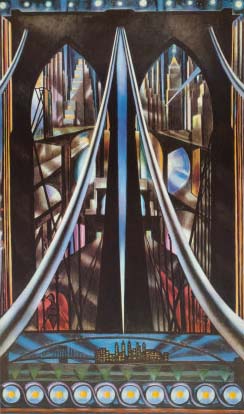
The Brooklyn Bridgealso known as The Bridge

|
In 1939, Joseph Stella, an Italian immigrant tried to capture the excitement he found on the city streets of New York in his painting The Brooklyn Bridge. Stella saw this bridge as a force of inspiration, and a symbol of technology.
The work is dominated by the huge black tower of the bridge, a monument to technology, as it is the first steel cable suspension in the world. From this immense structure run small, shaded suspension cables that rise up toward the summit of the bridge. Also, toward the bottom of the painting, electric lights brighten an otherwise pale foreground. Each of these aspects depicted in The Brooklyn Bridge serves to demonstrate Stella’s optimistic attitude toward progress as a means for a better tomorrow.
The optimism is also seen in the religious imagery that is portrayed in this painting. For example, the large towers of the bridge are shaped like the stained glass windows of a gothic cathedral and it seems as if you get a glimpse of heaven through the arches.
The first thing you focus on when looking at the Brooklyn Bridge is the oppressive darkness of this structure. In the foreground, you then notice the bright sky behind the bridge tower. Black vertical cables obscure most of the background and the brick texture of the bridge tower is smooth black. However, a series of blue circles line the bottom of the image, forming a foundation for the bridge. These circles are tinged with a yellow hue, contrasting sharply with the serene blue sky of the background. There is not a single human form present in the painting.
Stella’s imagery present in the Brooklyn Bridge illustrates enthusiasm for technology and optimism for the future.












